Property Law & Real Estate Construction Law
VerifiedAdded on 2023/06/03
|12
|3116
|204
AI Summary
This article discusses various legal issues related to property law and real estate construction law in Canada. It covers topics such as civil and criminal proceedings, disciplinary consequences for providing false information, and the criteria for deciding ownership of property. It also includes case briefs on reported decisions related to trespass and aboriginal rights.
Contribute Materials
Your contribution can guide someone’s learning journey. Share your
documents today.

Running head: PROPERTY LAW & REAL ESTATE CONSTRUCTION LAW 1
Property Law & Real Estate Construction Law
Name of the student:
Name of the University:
Authors Note:
Property Law & Real Estate Construction Law
Name of the student:
Name of the University:
Authors Note:
Secure Best Marks with AI Grader
Need help grading? Try our AI Grader for instant feedback on your assignments.
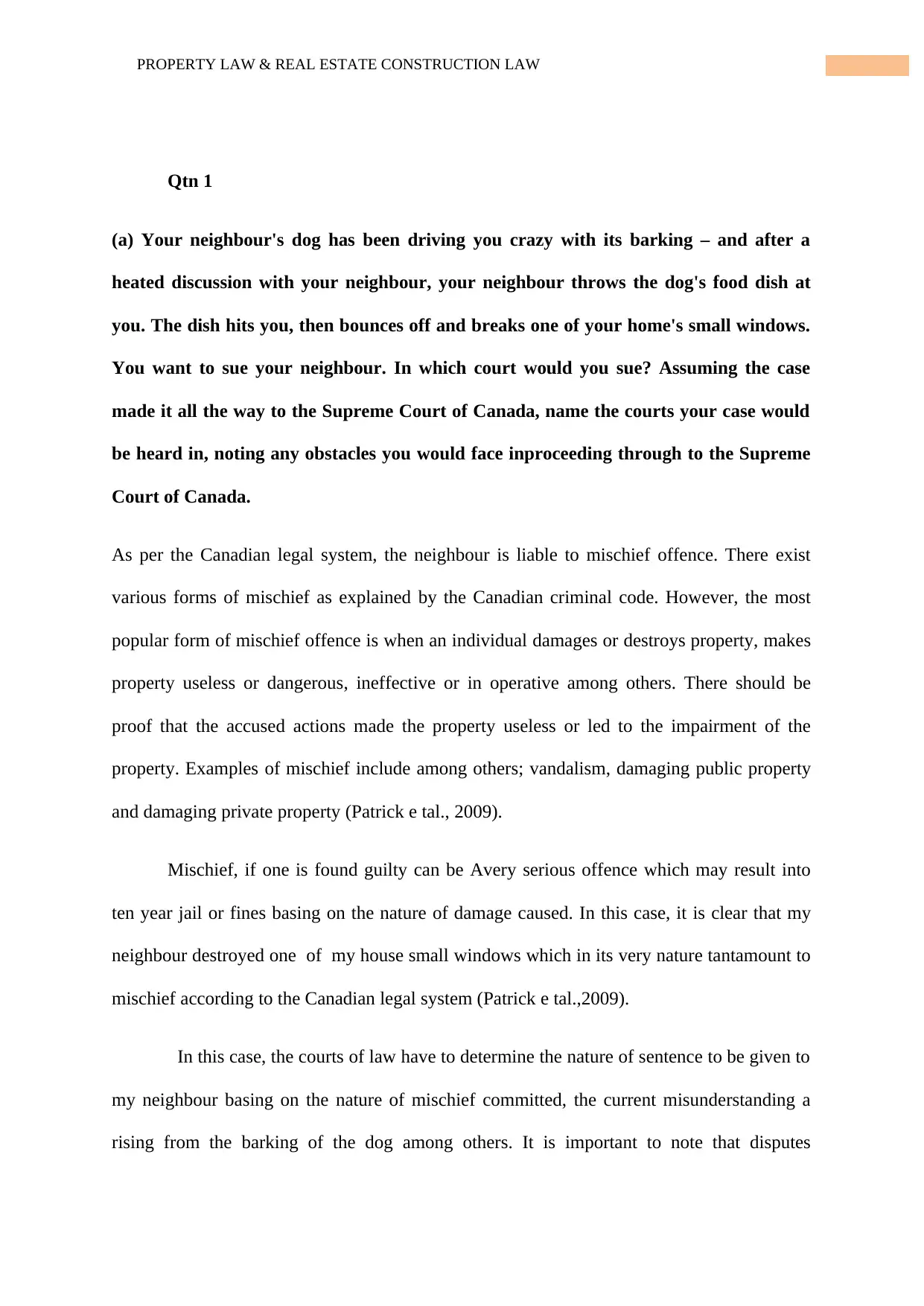
1PROPERTY LAW & REAL ESTATE CONSTRUCTION LAW
Qtn 1
(a) Your neighbour's dog has been driving you crazy with its barking – and after a
heated discussion with your neighbour, your neighbour throws the dog's food dish at
you. The dish hits you, then bounces off and breaks one of your home's small windows.
You want to sue your neighbour. In which court would you sue? Assuming the case
made it all the way to the Supreme Court of Canada, name the courts your case would
be heard in, noting any obstacles you would face inproceeding through to the Supreme
Court of Canada.
As per the Canadian legal system, the neighbour is liable to mischief offence. There exist
various forms of mischief as explained by the Canadian criminal code. However, the most
popular form of mischief offence is when an individual damages or destroys property, makes
property useless or dangerous, ineffective or in operative among others. There should be
proof that the accused actions made the property useless or led to the impairment of the
property. Examples of mischief include among others; vandalism, damaging public property
and damaging private property (Patrick e tal., 2009).
Mischief, if one is found guilty can be Avery serious offence which may result into
ten year jail or fines basing on the nature of damage caused. In this case, it is clear that my
neighbour destroyed one of my house small windows which in its very nature tantamount to
mischief according to the Canadian legal system (Patrick e tal.,2009).
In this case, the courts of law have to determine the nature of sentence to be given to
my neighbour basing on the nature of mischief committed, the current misunderstanding a
rising from the barking of the dog among others. It is important to note that disputes
Qtn 1
(a) Your neighbour's dog has been driving you crazy with its barking – and after a
heated discussion with your neighbour, your neighbour throws the dog's food dish at
you. The dish hits you, then bounces off and breaks one of your home's small windows.
You want to sue your neighbour. In which court would you sue? Assuming the case
made it all the way to the Supreme Court of Canada, name the courts your case would
be heard in, noting any obstacles you would face inproceeding through to the Supreme
Court of Canada.
As per the Canadian legal system, the neighbour is liable to mischief offence. There exist
various forms of mischief as explained by the Canadian criminal code. However, the most
popular form of mischief offence is when an individual damages or destroys property, makes
property useless or dangerous, ineffective or in operative among others. There should be
proof that the accused actions made the property useless or led to the impairment of the
property. Examples of mischief include among others; vandalism, damaging public property
and damaging private property (Patrick e tal., 2009).
Mischief, if one is found guilty can be Avery serious offence which may result into
ten year jail or fines basing on the nature of damage caused. In this case, it is clear that my
neighbour destroyed one of my house small windows which in its very nature tantamount to
mischief according to the Canadian legal system (Patrick e tal.,2009).
In this case, the courts of law have to determine the nature of sentence to be given to
my neighbour basing on the nature of mischief committed, the current misunderstanding a
rising from the barking of the dog among others. It is important to note that disputes
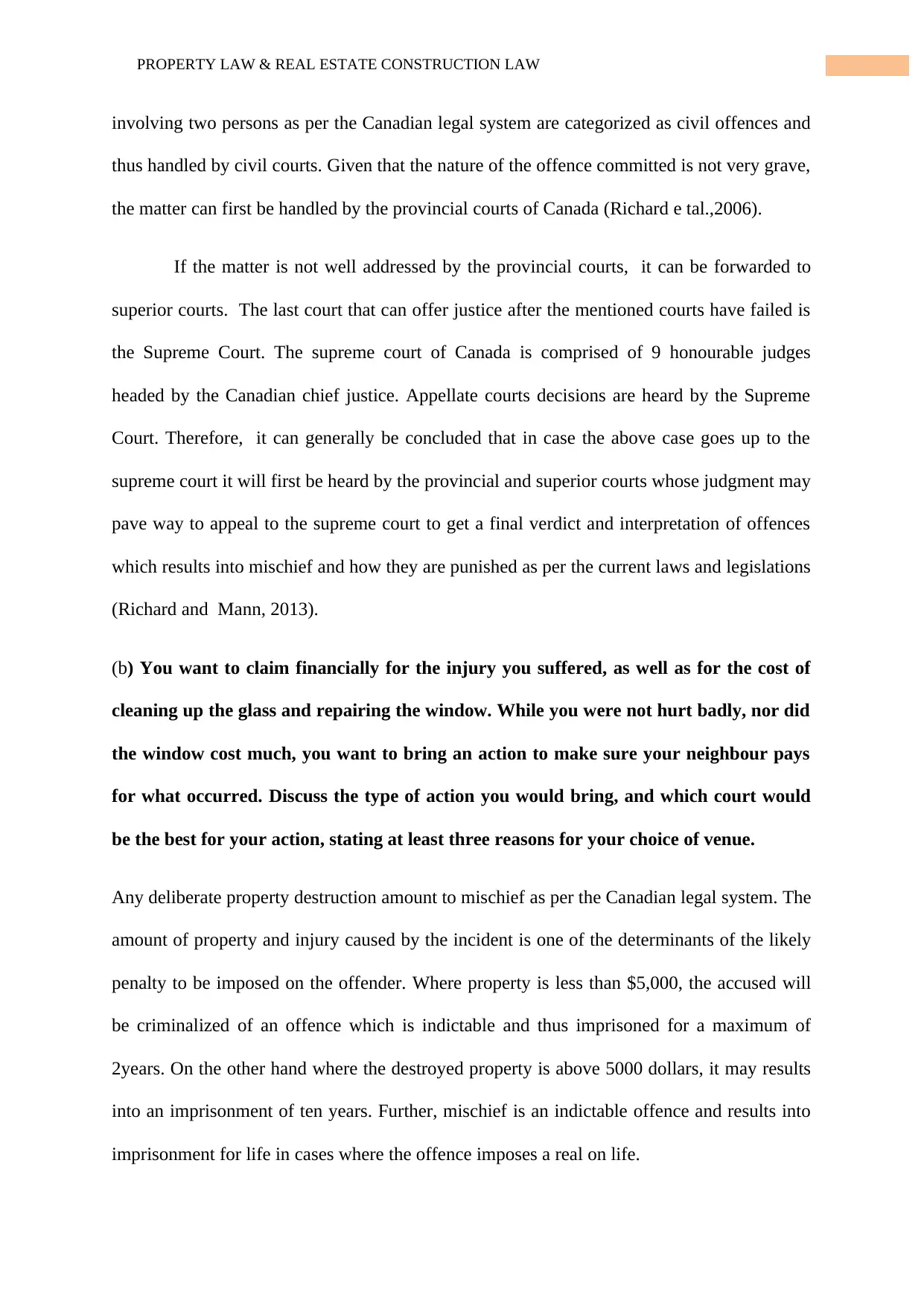
2PROPERTY LAW & REAL ESTATE CONSTRUCTION LAW
involving two persons as per the Canadian legal system are categorized as civil offences and
thus handled by civil courts. Given that the nature of the offence committed is not very grave,
the matter can first be handled by the provincial courts of Canada (Richard e tal.,2006).
If the matter is not well addressed by the provincial courts, it can be forwarded to
superior courts. The last court that can offer justice after the mentioned courts have failed is
the Supreme Court. The supreme court of Canada is comprised of 9 honourable judges
headed by the Canadian chief justice. Appellate courts decisions are heard by the Supreme
Court. Therefore, it can generally be concluded that in case the above case goes up to the
supreme court it will first be heard by the provincial and superior courts whose judgment may
pave way to appeal to the supreme court to get a final verdict and interpretation of offences
which results into mischief and how they are punished as per the current laws and legislations
(Richard and Mann, 2013).
(b) You want to claim financially for the injury you suffered, as well as for the cost of
cleaning up the glass and repairing the window. While you were not hurt badly, nor did
the window cost much, you want to bring an action to make sure your neighbour pays
for what occurred. Discuss the type of action you would bring, and which court would
be the best for your action, stating at least three reasons for your choice of venue.
Any deliberate property destruction amount to mischief as per the Canadian legal system. The
amount of property and injury caused by the incident is one of the determinants of the likely
penalty to be imposed on the offender. Where property is less than $5,000, the accused will
be criminalized of an offence which is indictable and thus imprisoned for a maximum of
2years. On the other hand where the destroyed property is above 5000 dollars, it may results
into an imprisonment of ten years. Further, mischief is an indictable offence and results into
imprisonment for life in cases where the offence imposes a real on life.
involving two persons as per the Canadian legal system are categorized as civil offences and
thus handled by civil courts. Given that the nature of the offence committed is not very grave,
the matter can first be handled by the provincial courts of Canada (Richard e tal.,2006).
If the matter is not well addressed by the provincial courts, it can be forwarded to
superior courts. The last court that can offer justice after the mentioned courts have failed is
the Supreme Court. The supreme court of Canada is comprised of 9 honourable judges
headed by the Canadian chief justice. Appellate courts decisions are heard by the Supreme
Court. Therefore, it can generally be concluded that in case the above case goes up to the
supreme court it will first be heard by the provincial and superior courts whose judgment may
pave way to appeal to the supreme court to get a final verdict and interpretation of offences
which results into mischief and how they are punished as per the current laws and legislations
(Richard and Mann, 2013).
(b) You want to claim financially for the injury you suffered, as well as for the cost of
cleaning up the glass and repairing the window. While you were not hurt badly, nor did
the window cost much, you want to bring an action to make sure your neighbour pays
for what occurred. Discuss the type of action you would bring, and which court would
be the best for your action, stating at least three reasons for your choice of venue.
Any deliberate property destruction amount to mischief as per the Canadian legal system. The
amount of property and injury caused by the incident is one of the determinants of the likely
penalty to be imposed on the offender. Where property is less than $5,000, the accused will
be criminalized of an offence which is indictable and thus imprisoned for a maximum of
2years. On the other hand where the destroyed property is above 5000 dollars, it may results
into an imprisonment of ten years. Further, mischief is an indictable offence and results into
imprisonment for life in cases where the offence imposes a real on life.
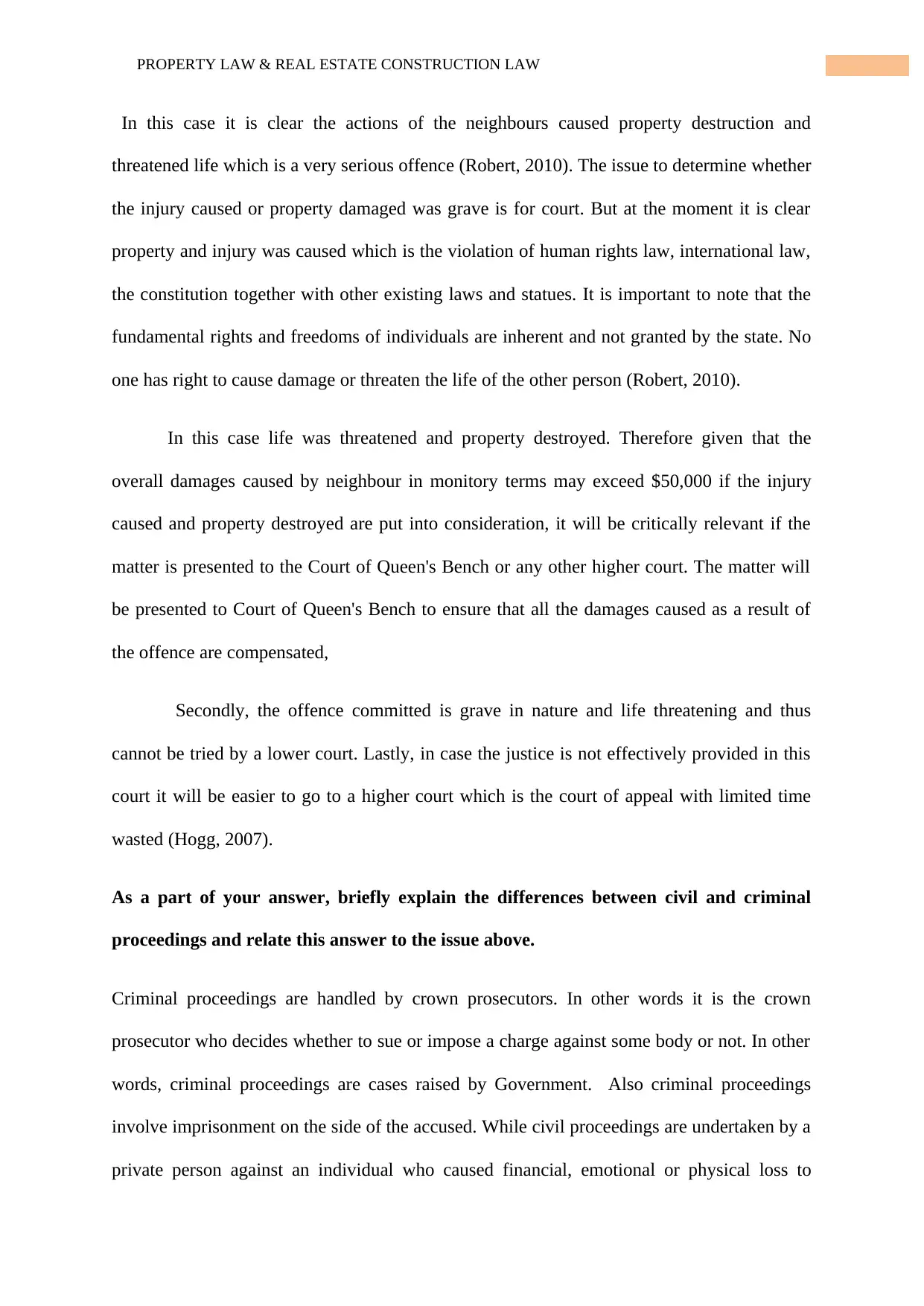
3PROPERTY LAW & REAL ESTATE CONSTRUCTION LAW
In this case it is clear the actions of the neighbours caused property destruction and
threatened life which is a very serious offence (Robert, 2010). The issue to determine whether
the injury caused or property damaged was grave is for court. But at the moment it is clear
property and injury was caused which is the violation of human rights law, international law,
the constitution together with other existing laws and statues. It is important to note that the
fundamental rights and freedoms of individuals are inherent and not granted by the state. No
one has right to cause damage or threaten the life of the other person (Robert, 2010).
In this case life was threatened and property destroyed. Therefore given that the
overall damages caused by neighbour in monitory terms may exceed $50,000 if the injury
caused and property destroyed are put into consideration, it will be critically relevant if the
matter is presented to the Court of Queen's Bench or any other higher court. The matter will
be presented to Court of Queen's Bench to ensure that all the damages caused as a result of
the offence are compensated,
Secondly, the offence committed is grave in nature and life threatening and thus
cannot be tried by a lower court. Lastly, in case the justice is not effectively provided in this
court it will be easier to go to a higher court which is the court of appeal with limited time
wasted (Hogg, 2007).
As a part of your answer, briefly explain the differences between civil and criminal
proceedings and relate this answer to the issue above.
Criminal proceedings are handled by crown prosecutors. In other words it is the crown
prosecutor who decides whether to sue or impose a charge against some body or not. In other
words, criminal proceedings are cases raised by Government. Also criminal proceedings
involve imprisonment on the side of the accused. While civil proceedings are undertaken by a
private person against an individual who caused financial, emotional or physical loss to
In this case it is clear the actions of the neighbours caused property destruction and
threatened life which is a very serious offence (Robert, 2010). The issue to determine whether
the injury caused or property damaged was grave is for court. But at the moment it is clear
property and injury was caused which is the violation of human rights law, international law,
the constitution together with other existing laws and statues. It is important to note that the
fundamental rights and freedoms of individuals are inherent and not granted by the state. No
one has right to cause damage or threaten the life of the other person (Robert, 2010).
In this case life was threatened and property destroyed. Therefore given that the
overall damages caused by neighbour in monitory terms may exceed $50,000 if the injury
caused and property destroyed are put into consideration, it will be critically relevant if the
matter is presented to the Court of Queen's Bench or any other higher court. The matter will
be presented to Court of Queen's Bench to ensure that all the damages caused as a result of
the offence are compensated,
Secondly, the offence committed is grave in nature and life threatening and thus
cannot be tried by a lower court. Lastly, in case the justice is not effectively provided in this
court it will be easier to go to a higher court which is the court of appeal with limited time
wasted (Hogg, 2007).
As a part of your answer, briefly explain the differences between civil and criminal
proceedings and relate this answer to the issue above.
Criminal proceedings are handled by crown prosecutors. In other words it is the crown
prosecutor who decides whether to sue or impose a charge against some body or not. In other
words, criminal proceedings are cases raised by Government. Also criminal proceedings
involve imprisonment on the side of the accused. While civil proceedings are undertaken by a
private person against an individual who caused financial, emotional or physical loss to
Secure Best Marks with AI Grader
Need help grading? Try our AI Grader for instant feedback on your assignments.
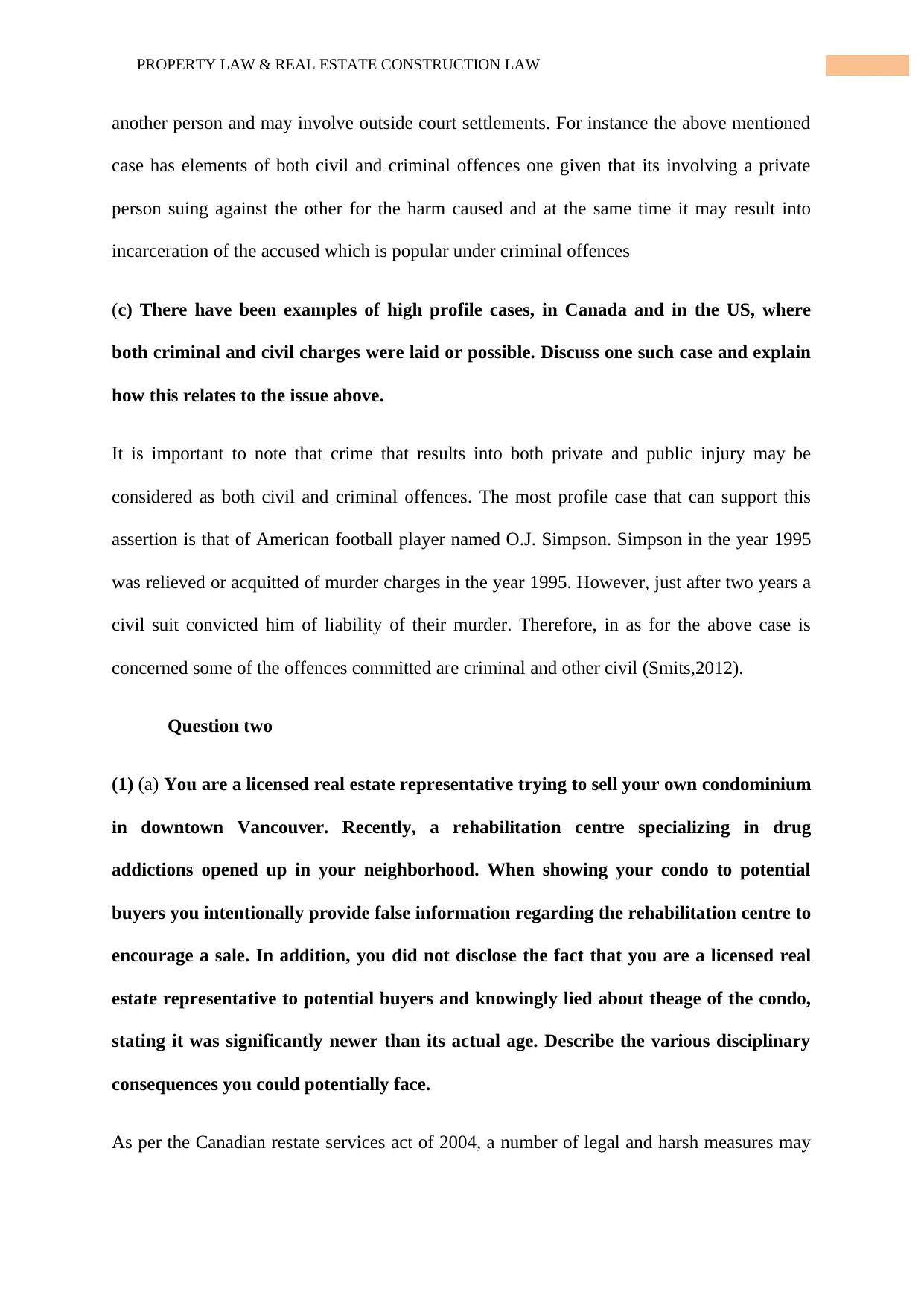
4PROPERTY LAW & REAL ESTATE CONSTRUCTION LAW
another person and may involve outside court settlements. For instance the above mentioned
case has elements of both civil and criminal offences one given that its involving a private
person suing against the other for the harm caused and at the same time it may result into
incarceration of the accused which is popular under criminal offences
(c) There have been examples of high profile cases, in Canada and in the US, where
both criminal and civil charges were laid or possible. Discuss one such case and explain
how this relates to the issue above.
It is important to note that crime that results into both private and public injury may be
considered as both civil and criminal offences. The most profile case that can support this
assertion is that of American football player named O.J. Simpson. Simpson in the year 1995
was relieved or acquitted of murder charges in the year 1995. However, just after two years a
civil suit convicted him of liability of their murder. Therefore, in as for the above case is
concerned some of the offences committed are criminal and other civil (Smits,2012).
Question two
(1) (a) You are a licensed real estate representative trying to sell your own condominium
in downtown Vancouver. Recently, a rehabilitation centre specializing in drug
addictions opened up in your neighborhood. When showing your condo to potential
buyers you intentionally provide false information regarding the rehabilitation centre to
encourage a sale. In addition, you did not disclose the fact that you are a licensed real
estate representative to potential buyers and knowingly lied about theage of the condo,
stating it was significantly newer than its actual age. Describe the various disciplinary
consequences you could potentially face.
As per the Canadian restate services act of 2004, a number of legal and harsh measures may
another person and may involve outside court settlements. For instance the above mentioned
case has elements of both civil and criminal offences one given that its involving a private
person suing against the other for the harm caused and at the same time it may result into
incarceration of the accused which is popular under criminal offences
(c) There have been examples of high profile cases, in Canada and in the US, where
both criminal and civil charges were laid or possible. Discuss one such case and explain
how this relates to the issue above.
It is important to note that crime that results into both private and public injury may be
considered as both civil and criminal offences. The most profile case that can support this
assertion is that of American football player named O.J. Simpson. Simpson in the year 1995
was relieved or acquitted of murder charges in the year 1995. However, just after two years a
civil suit convicted him of liability of their murder. Therefore, in as for the above case is
concerned some of the offences committed are criminal and other civil (Smits,2012).
Question two
(1) (a) You are a licensed real estate representative trying to sell your own condominium
in downtown Vancouver. Recently, a rehabilitation centre specializing in drug
addictions opened up in your neighborhood. When showing your condo to potential
buyers you intentionally provide false information regarding the rehabilitation centre to
encourage a sale. In addition, you did not disclose the fact that you are a licensed real
estate representative to potential buyers and knowingly lied about theage of the condo,
stating it was significantly newer than its actual age. Describe the various disciplinary
consequences you could potentially face.
As per the Canadian restate services act of 2004, a number of legal and harsh measures may
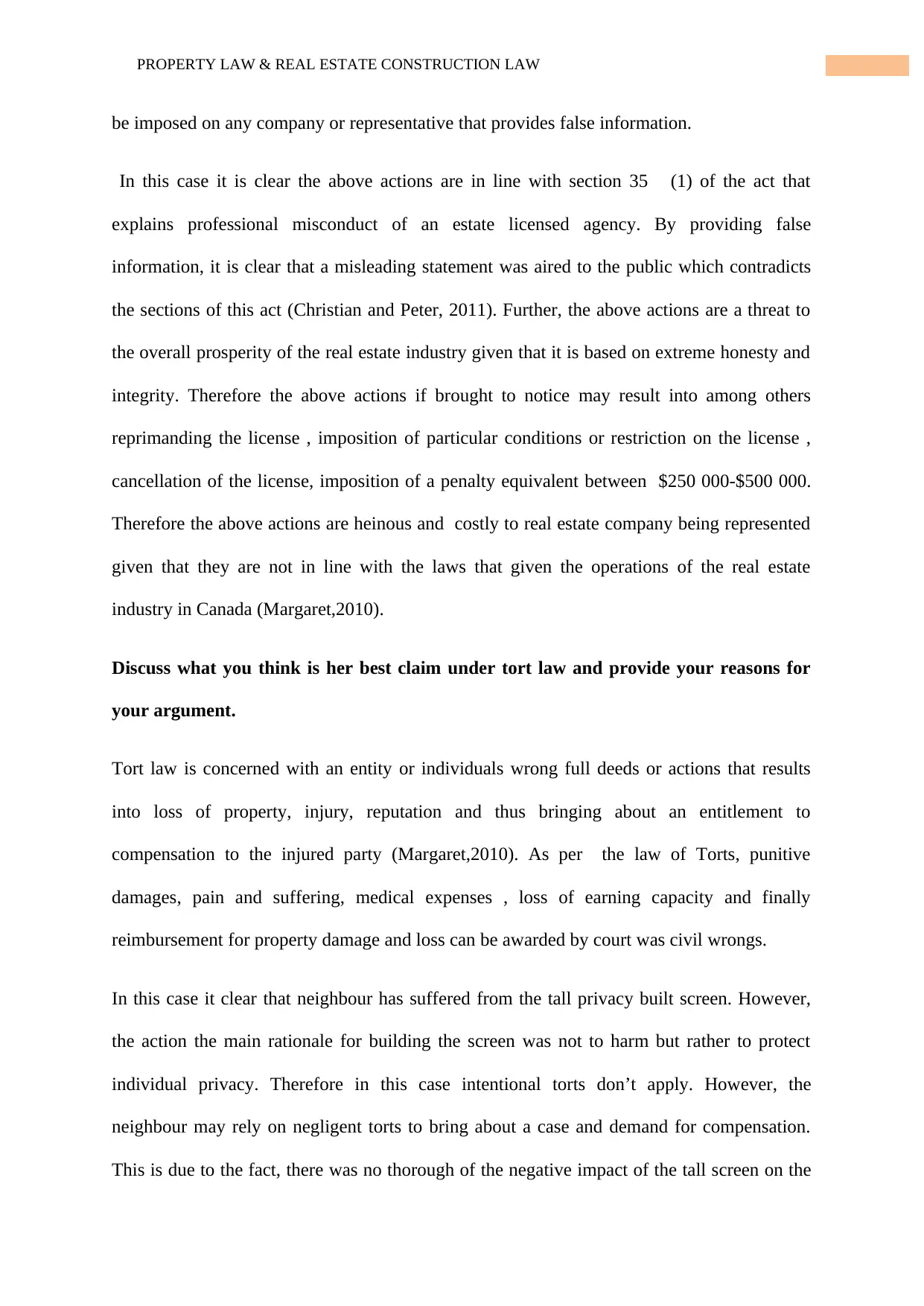
5PROPERTY LAW & REAL ESTATE CONSTRUCTION LAW
be imposed on any company or representative that provides false information.
In this case it is clear the above actions are in line with section 35 (1) of the act that
explains professional misconduct of an estate licensed agency. By providing false
information, it is clear that a misleading statement was aired to the public which contradicts
the sections of this act (Christian and Peter, 2011). Further, the above actions are a threat to
the overall prosperity of the real estate industry given that it is based on extreme honesty and
integrity. Therefore the above actions if brought to notice may result into among others
reprimanding the license , imposition of particular conditions or restriction on the license ,
cancellation of the license, imposition of a penalty equivalent between $250 000-$500 000.
Therefore the above actions are heinous and costly to real estate company being represented
given that they are not in line with the laws that given the operations of the real estate
industry in Canada (Margaret,2010).
Discuss what you think is her best claim under tort law and provide your reasons for
your argument.
Tort law is concerned with an entity or individuals wrong full deeds or actions that results
into loss of property, injury, reputation and thus bringing about an entitlement to
compensation to the injured party (Margaret,2010). As per the law of Torts, punitive
damages, pain and suffering, medical expenses , loss of earning capacity and finally
reimbursement for property damage and loss can be awarded by court was civil wrongs.
In this case it clear that neighbour has suffered from the tall privacy built screen. However,
the action the main rationale for building the screen was not to harm but rather to protect
individual privacy. Therefore in this case intentional torts don’t apply. However, the
neighbour may rely on negligent torts to bring about a case and demand for compensation.
This is due to the fact, there was no thorough of the negative impact of the tall screen on the
be imposed on any company or representative that provides false information.
In this case it is clear the above actions are in line with section 35 (1) of the act that
explains professional misconduct of an estate licensed agency. By providing false
information, it is clear that a misleading statement was aired to the public which contradicts
the sections of this act (Christian and Peter, 2011). Further, the above actions are a threat to
the overall prosperity of the real estate industry given that it is based on extreme honesty and
integrity. Therefore the above actions if brought to notice may result into among others
reprimanding the license , imposition of particular conditions or restriction on the license ,
cancellation of the license, imposition of a penalty equivalent between $250 000-$500 000.
Therefore the above actions are heinous and costly to real estate company being represented
given that they are not in line with the laws that given the operations of the real estate
industry in Canada (Margaret,2010).
Discuss what you think is her best claim under tort law and provide your reasons for
your argument.
Tort law is concerned with an entity or individuals wrong full deeds or actions that results
into loss of property, injury, reputation and thus bringing about an entitlement to
compensation to the injured party (Margaret,2010). As per the law of Torts, punitive
damages, pain and suffering, medical expenses , loss of earning capacity and finally
reimbursement for property damage and loss can be awarded by court was civil wrongs.
In this case it clear that neighbour has suffered from the tall privacy built screen. However,
the action the main rationale for building the screen was not to harm but rather to protect
individual privacy. Therefore in this case intentional torts don’t apply. However, the
neighbour may rely on negligent torts to bring about a case and demand for compensation.
This is due to the fact, there was no thorough of the negative impact of the tall screen on the
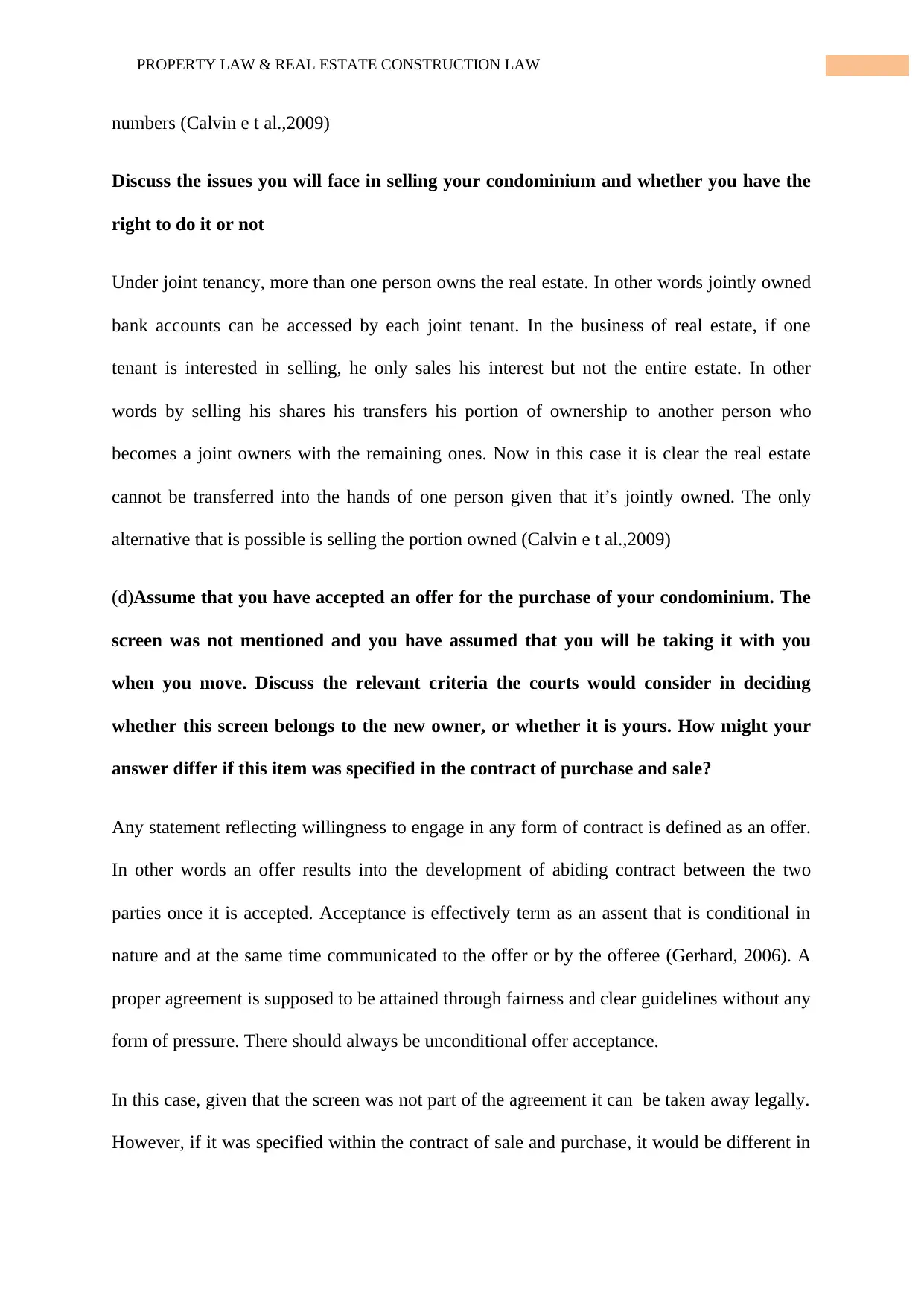
6PROPERTY LAW & REAL ESTATE CONSTRUCTION LAW
numbers (Calvin e t al.,2009)
Discuss the issues you will face in selling your condominium and whether you have the
right to do it or not
Under joint tenancy, more than one person owns the real estate. In other words jointly owned
bank accounts can be accessed by each joint tenant. In the business of real estate, if one
tenant is interested in selling, he only sales his interest but not the entire estate. In other
words by selling his shares his transfers his portion of ownership to another person who
becomes a joint owners with the remaining ones. Now in this case it is clear the real estate
cannot be transferred into the hands of one person given that it’s jointly owned. The only
alternative that is possible is selling the portion owned (Calvin e t al.,2009)
(d)Assume that you have accepted an offer for the purchase of your condominium. The
screen was not mentioned and you have assumed that you will be taking it with you
when you move. Discuss the relevant criteria the courts would consider in deciding
whether this screen belongs to the new owner, or whether it is yours. How might your
answer differ if this item was specified in the contract of purchase and sale?
Any statement reflecting willingness to engage in any form of contract is defined as an offer.
In other words an offer results into the development of abiding contract between the two
parties once it is accepted. Acceptance is effectively term as an assent that is conditional in
nature and at the same time communicated to the offer or by the offeree (Gerhard, 2006). A
proper agreement is supposed to be attained through fairness and clear guidelines without any
form of pressure. There should always be unconditional offer acceptance.
In this case, given that the screen was not part of the agreement it can be taken away legally.
However, if it was specified within the contract of sale and purchase, it would be different in
numbers (Calvin e t al.,2009)
Discuss the issues you will face in selling your condominium and whether you have the
right to do it or not
Under joint tenancy, more than one person owns the real estate. In other words jointly owned
bank accounts can be accessed by each joint tenant. In the business of real estate, if one
tenant is interested in selling, he only sales his interest but not the entire estate. In other
words by selling his shares his transfers his portion of ownership to another person who
becomes a joint owners with the remaining ones. Now in this case it is clear the real estate
cannot be transferred into the hands of one person given that it’s jointly owned. The only
alternative that is possible is selling the portion owned (Calvin e t al.,2009)
(d)Assume that you have accepted an offer for the purchase of your condominium. The
screen was not mentioned and you have assumed that you will be taking it with you
when you move. Discuss the relevant criteria the courts would consider in deciding
whether this screen belongs to the new owner, or whether it is yours. How might your
answer differ if this item was specified in the contract of purchase and sale?
Any statement reflecting willingness to engage in any form of contract is defined as an offer.
In other words an offer results into the development of abiding contract between the two
parties once it is accepted. Acceptance is effectively term as an assent that is conditional in
nature and at the same time communicated to the offer or by the offeree (Gerhard, 2006). A
proper agreement is supposed to be attained through fairness and clear guidelines without any
form of pressure. There should always be unconditional offer acceptance.
In this case, given that the screen was not part of the agreement it can be taken away legally.
However, if it was specified within the contract of sale and purchase, it would be different in
Paraphrase This Document
Need a fresh take? Get an instant paraphrase of this document with our AI Paraphraser
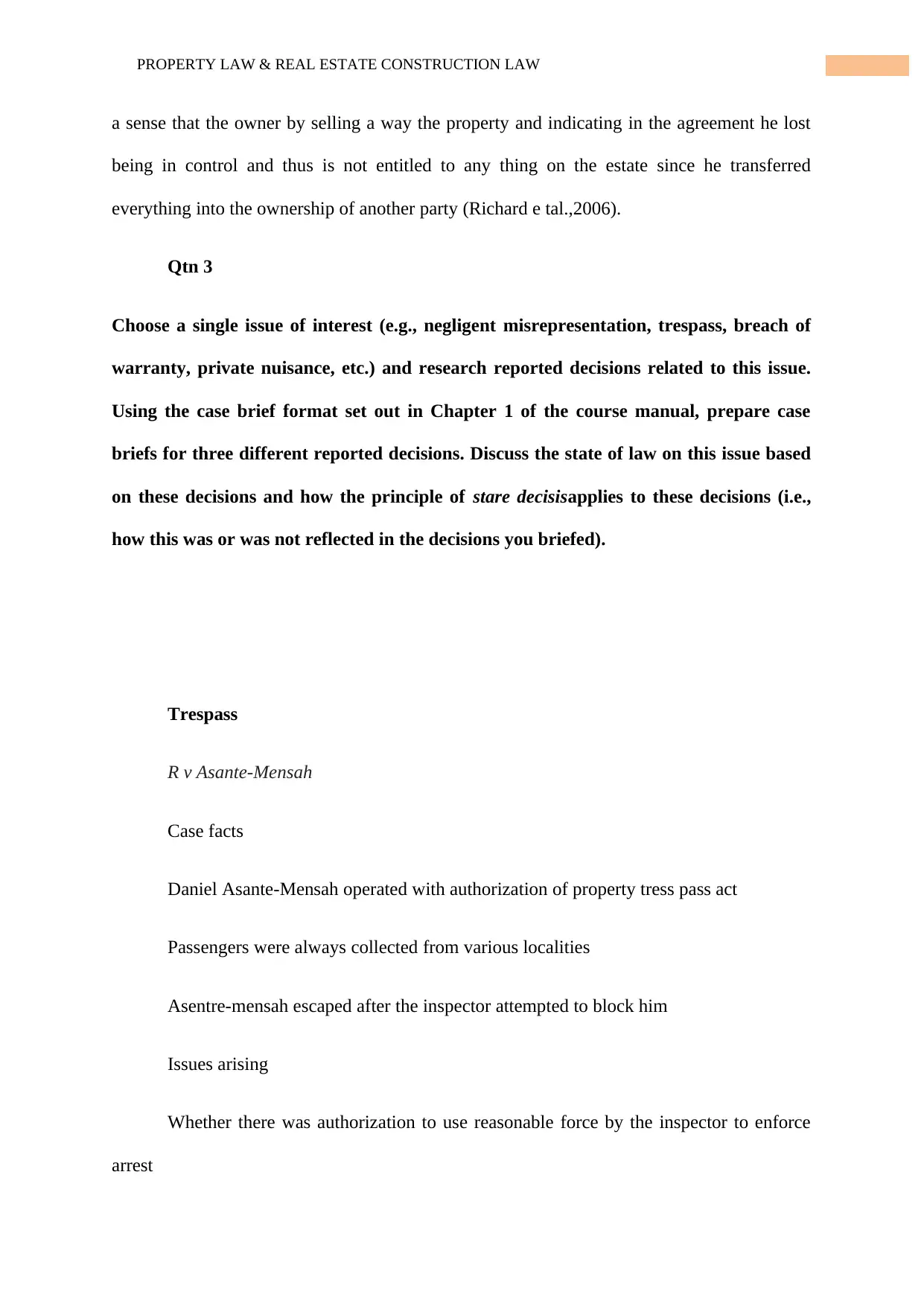
7PROPERTY LAW & REAL ESTATE CONSTRUCTION LAW
a sense that the owner by selling a way the property and indicating in the agreement he lost
being in control and thus is not entitled to any thing on the estate since he transferred
everything into the ownership of another party (Richard e tal.,2006).
Qtn 3
Choose a single issue of interest (e.g., negligent misrepresentation, trespass, breach of
warranty, private nuisance, etc.) and research reported decisions related to this issue.
Using the case brief format set out in Chapter 1 of the course manual, prepare case
briefs for three different reported decisions. Discuss the state of law on this issue based
on these decisions and how the principle of stare decisisapplies to these decisions (i.e.,
how this was or was not reflected in the decisions you briefed).
Trespass
R v Asante-Mensah
Case facts
Daniel Asante-Mensah operated with authorization of property tress pass act
Passengers were always collected from various localities
Asentre-mensah escaped after the inspector attempted to block him
Issues arising
Whether there was authorization to use reasonable force by the inspector to enforce
arrest
a sense that the owner by selling a way the property and indicating in the agreement he lost
being in control and thus is not entitled to any thing on the estate since he transferred
everything into the ownership of another party (Richard e tal.,2006).
Qtn 3
Choose a single issue of interest (e.g., negligent misrepresentation, trespass, breach of
warranty, private nuisance, etc.) and research reported decisions related to this issue.
Using the case brief format set out in Chapter 1 of the course manual, prepare case
briefs for three different reported decisions. Discuss the state of law on this issue based
on these decisions and how the principle of stare decisisapplies to these decisions (i.e.,
how this was or was not reflected in the decisions you briefed).
Trespass
R v Asante-Mensah
Case facts
Daniel Asante-Mensah operated with authorization of property tress pass act
Passengers were always collected from various localities
Asentre-mensah escaped after the inspector attempted to block him
Issues arising
Whether there was authorization to use reasonable force by the inspector to enforce
arrest
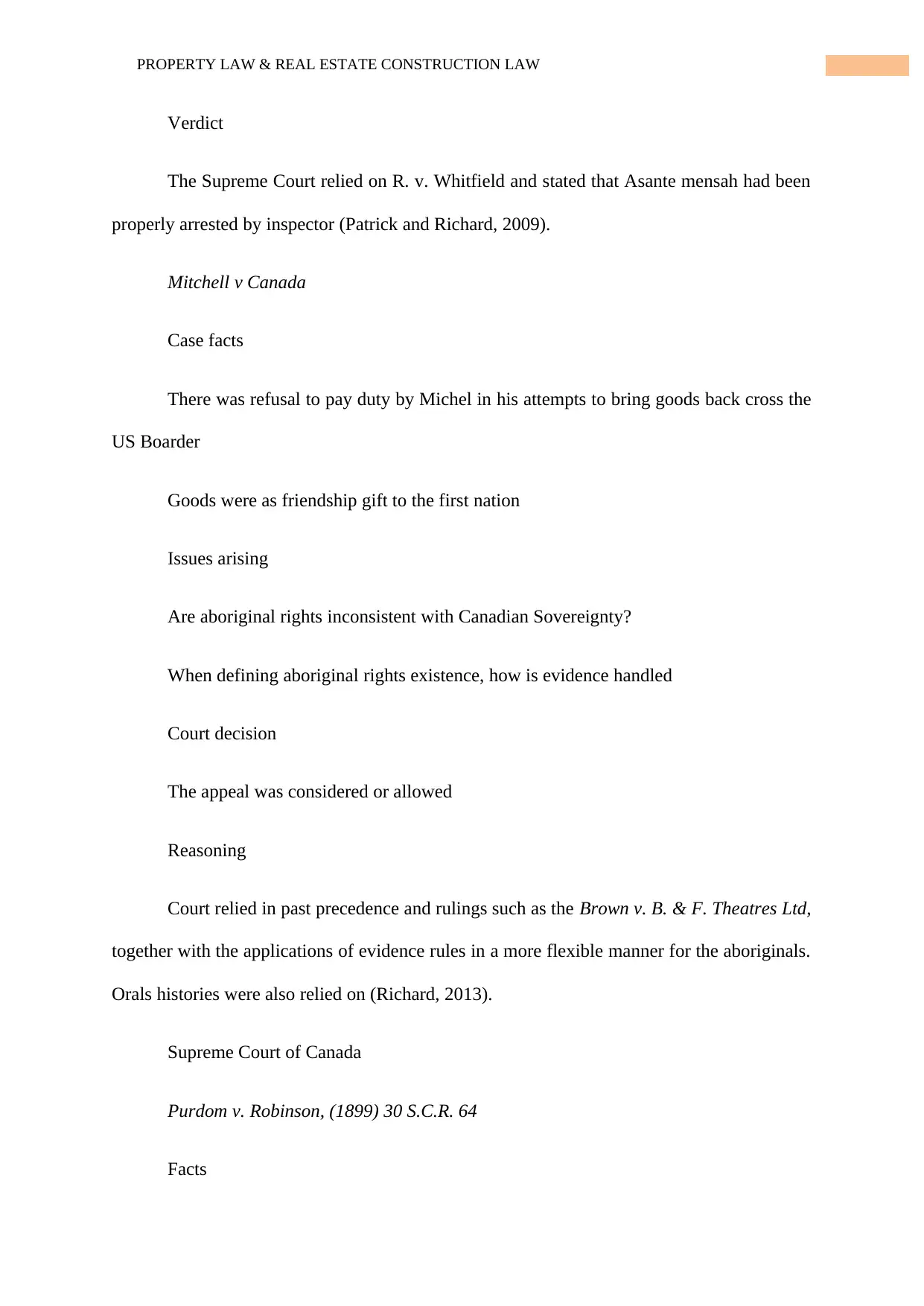
8PROPERTY LAW & REAL ESTATE CONSTRUCTION LAW
Verdict
The Supreme Court relied on R. v. Whitfield and stated that Asante mensah had been
properly arrested by inspector (Patrick and Richard, 2009).
Mitchell v Canada
Case facts
There was refusal to pay duty by Michel in his attempts to bring goods back cross the
US Boarder
Goods were as friendship gift to the first nation
Issues arising
Are aboriginal rights inconsistent with Canadian Sovereignty?
When defining aboriginal rights existence, how is evidence handled
Court decision
The appeal was considered or allowed
Reasoning
Court relied in past precedence and rulings such as the Brown v. B. & F. Theatres Ltd,
together with the applications of evidence rules in a more flexible manner for the aboriginals.
Orals histories were also relied on (Richard, 2013).
Supreme Court of Canada
Purdom v. Robinson, (1899) 30 S.C.R. 64
Facts
Verdict
The Supreme Court relied on R. v. Whitfield and stated that Asante mensah had been
properly arrested by inspector (Patrick and Richard, 2009).
Mitchell v Canada
Case facts
There was refusal to pay duty by Michel in his attempts to bring goods back cross the
US Boarder
Goods were as friendship gift to the first nation
Issues arising
Are aboriginal rights inconsistent with Canadian Sovereignty?
When defining aboriginal rights existence, how is evidence handled
Court decision
The appeal was considered or allowed
Reasoning
Court relied in past precedence and rulings such as the Brown v. B. & F. Theatres Ltd,
together with the applications of evidence rules in a more flexible manner for the aboriginals.
Orals histories were also relied on (Richard, 2013).
Supreme Court of Canada
Purdom v. Robinson, (1899) 30 S.C.R. 64
Facts
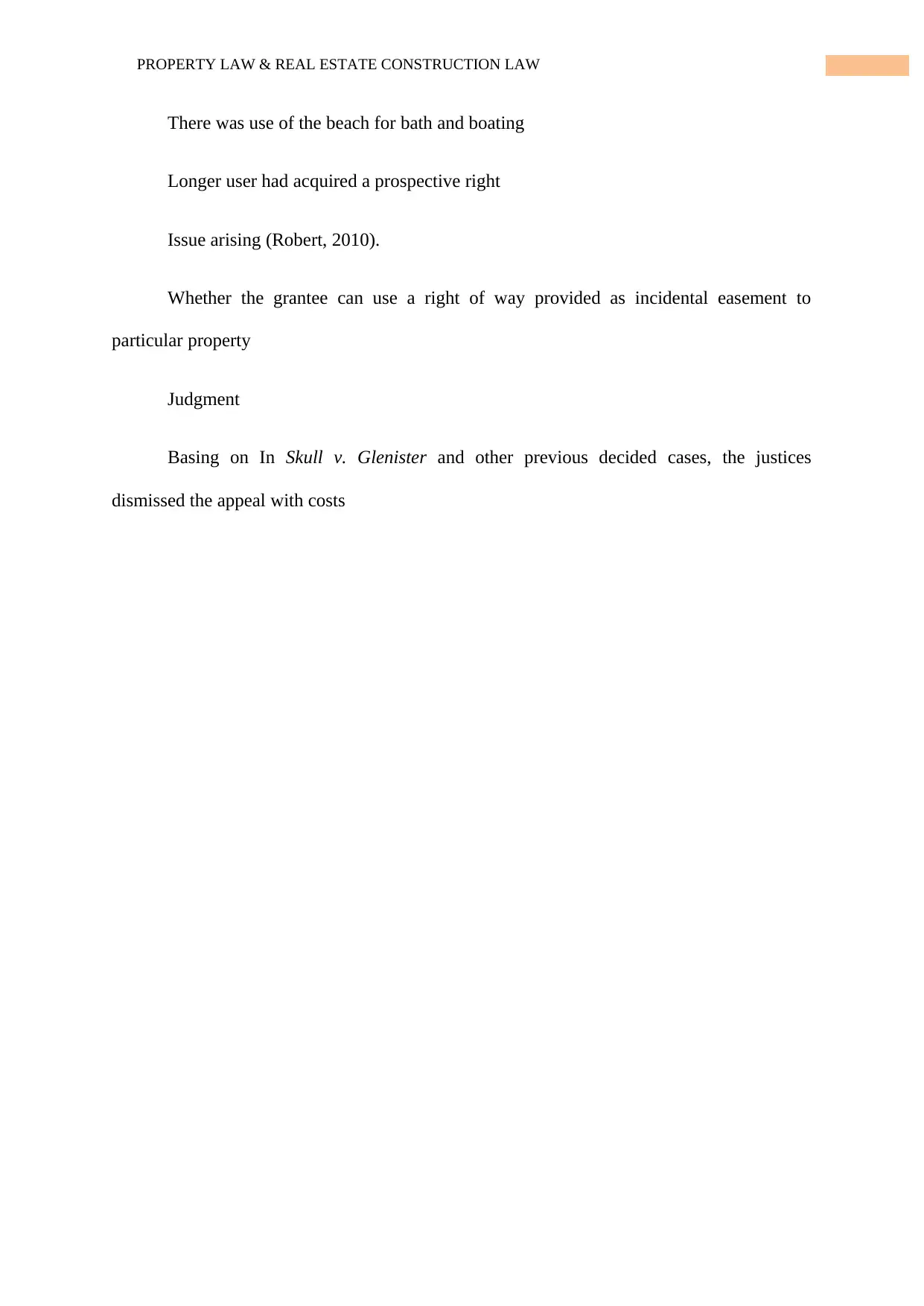
9PROPERTY LAW & REAL ESTATE CONSTRUCTION LAW
There was use of the beach for bath and boating
Longer user had acquired a prospective right
Issue arising (Robert, 2010).
Whether the grantee can use a right of way provided as incidental easement to
particular property
Judgment
Basing on In Skull v. Glenister and other previous decided cases, the justices
dismissed the appeal with costs
There was use of the beach for bath and boating
Longer user had acquired a prospective right
Issue arising (Robert, 2010).
Whether the grantee can use a right of way provided as incidental easement to
particular property
Judgment
Basing on In Skull v. Glenister and other previous decided cases, the justices
dismissed the appeal with costs
Secure Best Marks with AI Grader
Need help grading? Try our AI Grader for instant feedback on your assignments.

10PROPERTY LAW & REAL ESTATE CONSTRUCTION LAW
References
Richard, W. Bauman; Tsvi, Kahana .(2006). The Least Examined Branch: The Role of Legislatures
in the Constitutional State. Cambridge University Press. p. 159. ISBN 978-1-139-46040-8.
Patrick, N. Malcolmson; Richard, Myers. (2009). The Canadian Regime: An Introduction to
Parliamentary Government in Canada. University of Toronto Press. p. 149. ISBN 978-1-
4426-0047-8.
Richard, A. Mann. (2013). Business Law and the Regulation of Business. Cengage Learning. p. 7.
ISBN 978-1-133-58757-6.
Robert, A, B. (2010). Canada In Crisis...: An Agenda to Unify the Nation. Trafford Publishing. p. 26.
ISBN 978-1-4269-8062-6.
Hogg, P, W. (2007). Constitutional Law of Canada (5th ed.). Toronto: Carswell. pp. 8–9 — 8–11.
ISBN 9780779813377.
J. M. Smits. (2012). Elgar Encyclopedia of Comparative Law. Edward Elgar Publishing. p. 132.
ISBN 978-1-78100-610-8.
Christian, L; Peter H. R. (2011). Essential Readings in Canadian Constitutional Politics. University
of Toronto Press. p. 477. ISBN 978-1-4426-0368-4.
Margaret, A, W. (2010). Genealogy and the Law in Canada. Dundurn. ISBN 978-1-77070-585-2.
References
Richard, W. Bauman; Tsvi, Kahana .(2006). The Least Examined Branch: The Role of Legislatures
in the Constitutional State. Cambridge University Press. p. 159. ISBN 978-1-139-46040-8.
Patrick, N. Malcolmson; Richard, Myers. (2009). The Canadian Regime: An Introduction to
Parliamentary Government in Canada. University of Toronto Press. p. 149. ISBN 978-1-
4426-0047-8.
Richard, A. Mann. (2013). Business Law and the Regulation of Business. Cengage Learning. p. 7.
ISBN 978-1-133-58757-6.
Robert, A, B. (2010). Canada In Crisis...: An Agenda to Unify the Nation. Trafford Publishing. p. 26.
ISBN 978-1-4269-8062-6.
Hogg, P, W. (2007). Constitutional Law of Canada (5th ed.). Toronto: Carswell. pp. 8–9 — 8–11.
ISBN 9780779813377.
J. M. Smits. (2012). Elgar Encyclopedia of Comparative Law. Edward Elgar Publishing. p. 132.
ISBN 978-1-78100-610-8.
Christian, L; Peter H. R. (2011). Essential Readings in Canadian Constitutional Politics. University
of Toronto Press. p. 477. ISBN 978-1-4426-0368-4.
Margaret, A, W. (2010). Genealogy and the Law in Canada. Dundurn. ISBN 978-1-77070-585-2.
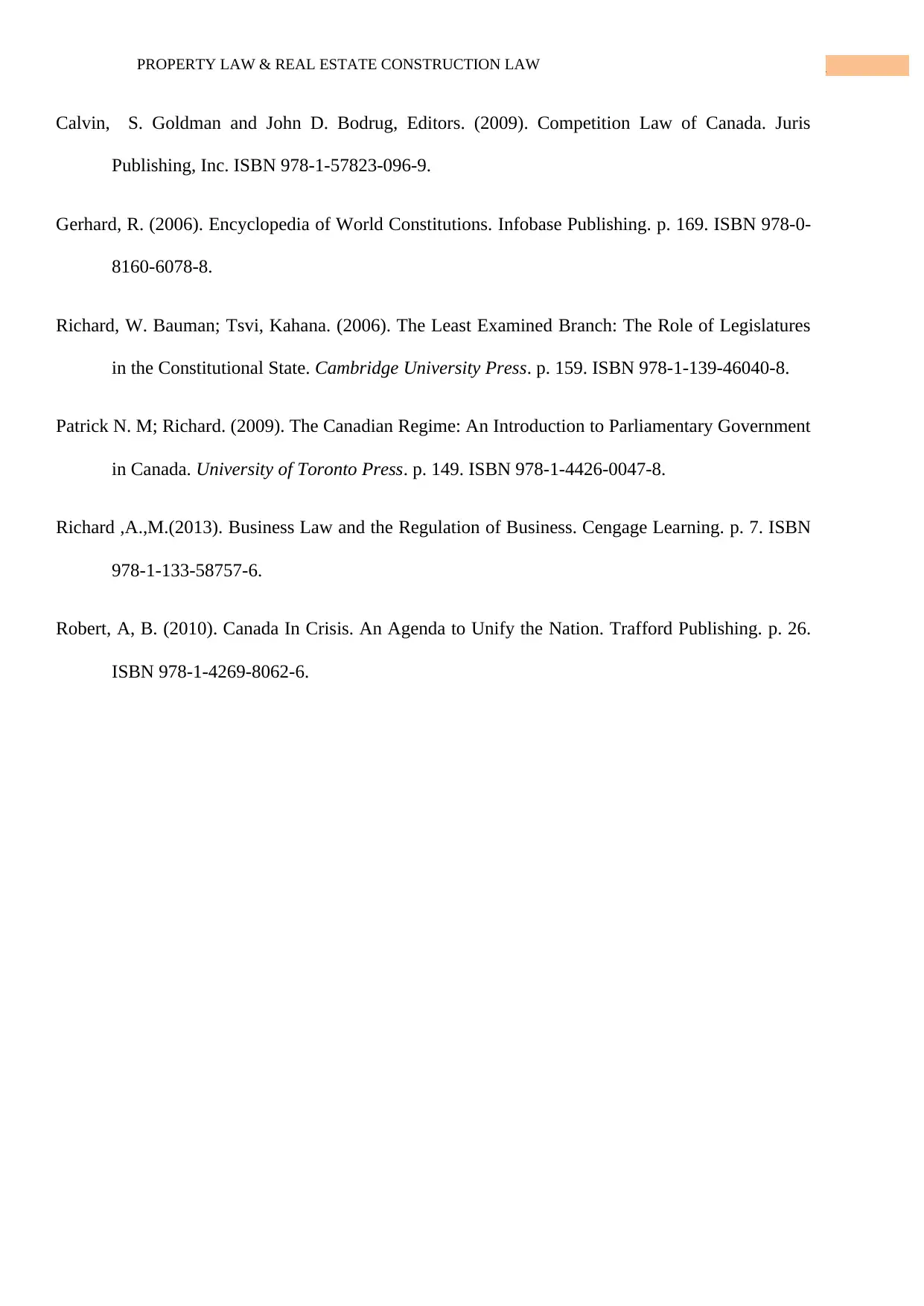
11PROPERTY LAW & REAL ESTATE CONSTRUCTION LAW
Calvin, S. Goldman and John D. Bodrug, Editors. (2009). Competition Law of Canada. Juris
Publishing, Inc. ISBN 978-1-57823-096-9.
Gerhard, R. (2006). Encyclopedia of World Constitutions. Infobase Publishing. p. 169. ISBN 978-0-
8160-6078-8.
Richard, W. Bauman; Tsvi, Kahana. (2006). The Least Examined Branch: The Role of Legislatures
in the Constitutional State. Cambridge University Press. p. 159. ISBN 978-1-139-46040-8.
Patrick N. M; Richard. (2009). The Canadian Regime: An Introduction to Parliamentary Government
in Canada. University of Toronto Press. p. 149. ISBN 978-1-4426-0047-8.
Richard ,A.,M.(2013). Business Law and the Regulation of Business. Cengage Learning. p. 7. ISBN
978-1-133-58757-6.
Robert, A, B. (2010). Canada In Crisis. An Agenda to Unify the Nation. Trafford Publishing. p. 26.
ISBN 978-1-4269-8062-6.
Calvin, S. Goldman and John D. Bodrug, Editors. (2009). Competition Law of Canada. Juris
Publishing, Inc. ISBN 978-1-57823-096-9.
Gerhard, R. (2006). Encyclopedia of World Constitutions. Infobase Publishing. p. 169. ISBN 978-0-
8160-6078-8.
Richard, W. Bauman; Tsvi, Kahana. (2006). The Least Examined Branch: The Role of Legislatures
in the Constitutional State. Cambridge University Press. p. 159. ISBN 978-1-139-46040-8.
Patrick N. M; Richard. (2009). The Canadian Regime: An Introduction to Parliamentary Government
in Canada. University of Toronto Press. p. 149. ISBN 978-1-4426-0047-8.
Richard ,A.,M.(2013). Business Law and the Regulation of Business. Cengage Learning. p. 7. ISBN
978-1-133-58757-6.
Robert, A, B. (2010). Canada In Crisis. An Agenda to Unify the Nation. Trafford Publishing. p. 26.
ISBN 978-1-4269-8062-6.
1 out of 12
Your All-in-One AI-Powered Toolkit for Academic Success.
+13062052269
info@desklib.com
Available 24*7 on WhatsApp / Email
![[object Object]](/_next/static/media/star-bottom.7253800d.svg)
Unlock your academic potential
© 2024 | Zucol Services PVT LTD | All rights reserved.
